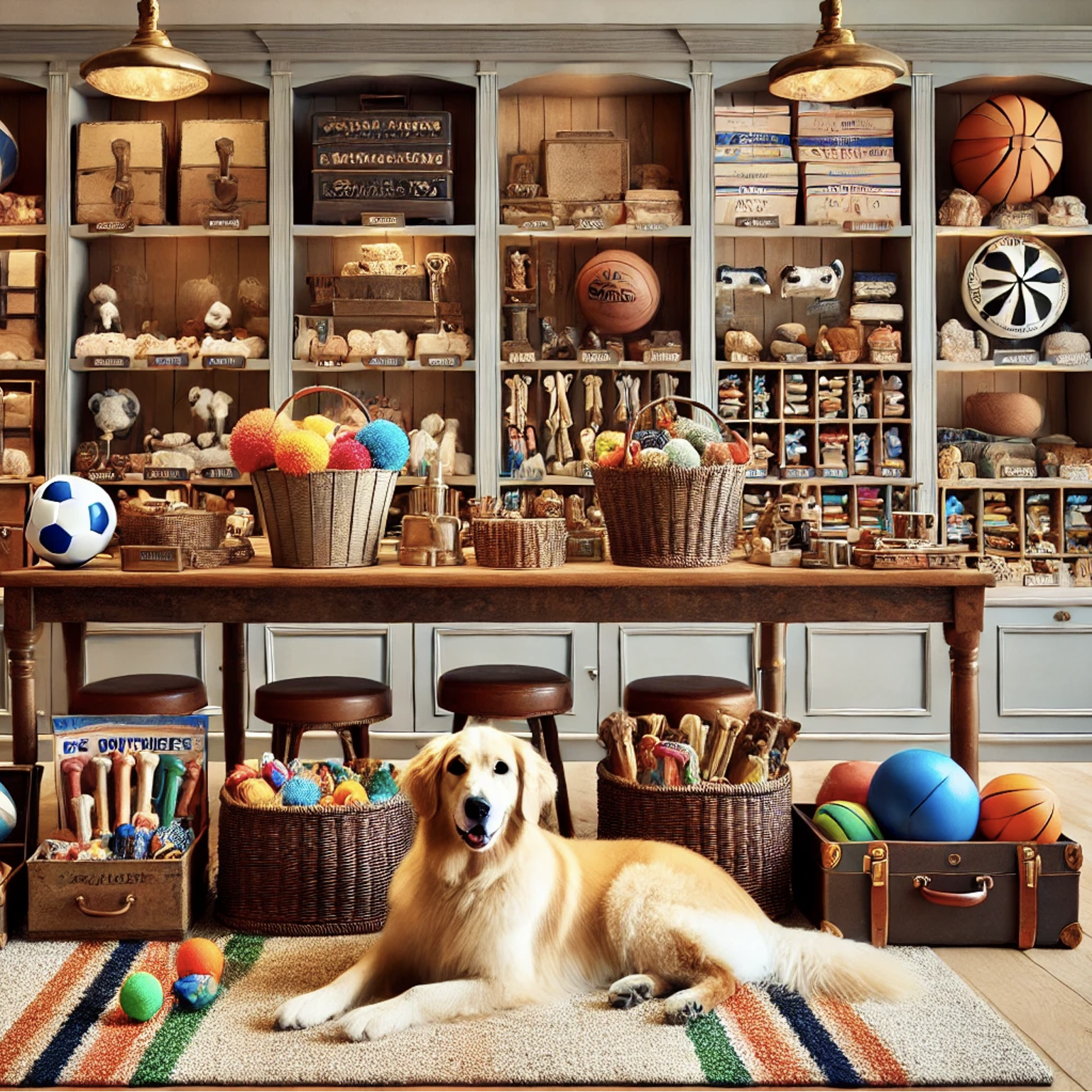Tailor-Made Pet Love: How to Show the Right Love to the Right Pet, Their Way
Tailor-Made Pet Love: How to Show the Right Love to the Right Pet, Their Way

Understanding Your Pet’s Unique Needs to Strengthen the Bond You Share
Written by: Cuddles, The Hedgehog
Hello, Wild Love Tail darlings! It’s me, Penelope the Hedgehog—writer, philosopher, and expert on matters of the heart (and fur). You might wonder how someone covered in quills could have so much to say about love, but trust me, love isn’t just about soft, snuggly cuddles. As someone who has to be careful with whom I cozy up to, I’ve learned a thing or two about navigating the wonderful, complex world of pet-human relationships. So, grab a cup of tea and let’s talk about how to build a love connection that’s so strong, your pets might just wag, purr, chirp, or slither their way into eternal devotion.
Find Out How Your Pet Loves To Be Loved, You Might Be Surprised!
In this article, I’ll share some general ways to express your love for pets and then take a deeper dive into the unique love languages of different pet types. While some of these pet love connections might surprise you, others will feel like old, familiar friends. I hope you enjoy this journey down the love canal—and don’t forget to share this blog with every pet lover you know. Let’s spread the LOVE!
The Love Language of Pets
1. Acts of Service: The Ultimate Tail Wagger
Just like a human partner might swoon when you cook their favorite meal, your pets adore acts of service. This might mean filling up their food bowl with the good stuff (you know, the one with the fancy packaging) or taking the time to scratch just the right spot behind their ears. Dogs, for instance, might love it when you take them on an extra-long walk and let them sniff EVERY tree in the neighborhood. For cats, it could be as simple as opening a sunbeam-facing window for their afternoon nap. The key is tuning in and figuring out what little gestures make their tails wag or whiskers twitch.
2. Words of Affirmation: Your Voice Says More Than Words
Oh, sweet talkers, this one’s for you! You might think your guinea pig doesn’t understand when you tell them they’re the most precious potato-shaped bundle of joy, but trust me—they do. Even reptiles enjoy hearing your soothing voice (though they’ll never admit it). It’s not about what you say but how you say it. So channel your inner poet, lay it on thick, and watch as your pets bask in the glow of your heartfelt praise. You might even try one of these Pet Language Translation Apps to see if you can talk pet talk. Body language also says alot, get to know what you pet is saying through the way they let their body talk.
3. Quality Time: Netflix and Nuzzle
Nothing says “I love you” like putting down your phone and spending some undivided attention with your pet. Maybe it’s a marathon of belly rubs for your pup, or for your hamster, it’s creating a little obstacle course to spice up their evening. Cats may act aloof, but trust me, they’re keeping tabs on how often you choose them over your emails. Even pets with simpler needs, like fish, appreciate a little one-on-one time—watching them swim can be oddly therapeutic (and they’ll feel the vibe).
4. Physical Touch: Paws-On Connection
For pets who crave physical affection, there’s no such thing as too many cuddles—unless, of course, you’re me. Hedgehog rule #1: Snuggles must be negotiated with great care! But whether your furry friend loves sprawling across your lap or prefers gentle pats, physical touch is a powerful way to bond. Just be mindful of their unique boundaries—some cats love a good cheek scratch, while others will karate-chop your hand for daring to touch their royal tummy.
5. Gift-Giving: Toys, Treats, and Trinkets
Did someone say surprise? Pets love little tokens of affection, and no, they don’t need to be expensive. A fresh chew toy, a new perch for your bird, or even just a crunchy treat goes a long way in saying, “You’re my favorite fluffball in the universe.” Bonus points if you make it a game—hide the treat or play tug-of-war to make the moment extra special. Some pets are pretty good gift givers too, so if you find a field mouse, bird or other catch by your door and hopefully not in your bed, yes that is a gift from you pet, so no screaming, just smile because you know they meant oh so well. Gift giving is not just about the gift, it is enriching the environemnt and providing entertainment.
6. Subtle Love: Understanding the Unspoken
Not all pets are loud about their needs. Some, like yours truly, might seem shy or distant. But love isn’t about forcing affection; it’s about respecting the quiet moments too. Learn their subtle cues—the flick of a tail, the soft chirp, or the way they rest their head on your knee. These are their ways of saying, “I’m here, and I’m happy with you.”
7. Two-Way Street: Love Takes Two (Or Three, Or Four)
Like any relationship, your bond with your pet is a two-way street. It’s about finding joy in their quirks and letting them bring out the best in you. After all, who else is going to love you when you’re in your mismatched pajamas at 2 AM, bribing them out from under the couch with treats?
8. Respect Boundaries: We All Have Different Love Languages
Some pets thrive on affection, while others prefer independence. Respect their comfort zones to help them feel secure. There is never a need to ‘push’ the affection, sometimes acting like you don’t want it will help a sky fella come around.
Grand gesters might be requred by your two legged friends, but us 4-legged friends are a little more easy going. We are good with almost anything so when preparing for a little personal pet time there is no need to dress up, no makeup require, purfume not necessary, bra optional, roses may be eaten, and dinner reservations upon request.
All your pet wants is your time, affection, and a few extra scratches in their favorite spot. So skip the reservations and show up for your furry date just as you are—they’ll love you unconditionally, bedhead and all.
So, whether it is one on one or a group date, remember this: Love is love, whether it’s a slobbery kiss, a loud purr, or the simple way they stay close by your side. With a little effort and a lot of heart, you can deepen your connection with your pet and create a bond that’s as timeless as it is adorable.
Love, Penelope the Hedgehog

Cuddles is a perceptive hedgehog writer who explores work-life balance, pet-owner relationships, and pet care, blending keen insights with warmth to enhance life, one pet at a time.
Keep Reading to Explore Pet Love Languages By Pet
Explore Showing and Receiving Love With Your Pets: Click To Find Out More
CAT LOVE

Cats are easy to adore, but their way of showing love can be a bit more nuanced than dogs. Every cat and breed has its unique personality, preferences, and love language. While some cats are naturally cuddly and social, others express their affection more subtly. Have fun exploring your cat’s unique love language and discovering all the ways they show their affection for you. When you meet them on their terms, the bond you share will be truly special.
Ways To Show Your Cat Love:
- Touch: Cats love touch, but they like it their way, some under chin, others across their back and others love their ears scratches. Pay attention to their body language to avoid overstimulation.
- Eye Contact: Take the time give your cat eye contact time.
- Playtime: Cats thrive on interactive play. Using toys like wands, lasers, or balls is a fantastic way to bond and show them you care.
- Grooming: Brushing your cat regularly not only keeps their coat healthy but also strengthens your connection. Cats groom each other as a form of affection, so they’ll appreciate your help!
- Space: Some cats love their independence. Giving them a cozy spot to relax or a perch to observe from afar shows respect for their boundaries.
How Your Cat Shows You Love:
- Touch: Many cats enjoy being pet in specific areas like under the chin, behind the ears, or along their back. Pay attention to their body language to avoid overstimulation.
- Eye Contact: Cats kiss with their eyes. Cats do something called Slow Blinking when they are comfortable with you, watch for it.
- Purring and Kneading: Cats express love through purring and kneading. If your cat chooses your lap or favorite chair to knead, it’s a sign of trust and affection.
- Gifts: Cats sometimes bring you toys, random objects, or even the occasional (ahem) “real-life prey” as a way to show their affection. It’s their way of sharing with you.
- Grooming: Cats will sometimes lick your hair, arm, or hand, letting you know they care.
- Tail: Cats communicate a lot through their tails! An upright, quivering tail shows happiness and affection.
- Visit: Cats sleep alot, but when they are awake and take the time to come and find you, they are saying hello!
Tip: Give new kitties time and patience to allow them to overcome any worries and allow them to begin building the relationship with you.
CATS: love and affection
These are the most affectionate cats:
Ragdolls are famous for their laid-back, affectionate personalities. They love being held and will often go limp in your arms, earning their name.
Maine Coons are the “gentle giants” of the cat world. They’re known for their dog-like loyalty and love to follow their humans around the house.
Sphynx Cats may be hairless, but they’re overflowing with warmth and love. They crave attention and snuggle time, making them one of the most affectionate breeds.
Persians are calm and loving, preferring quiet environments where they can bond with their favorite people. Their gentle nature makes them fantastic lap cats.
Scottish Folds with their adorable folded ears, are as sweet as they look. They’re known to form strong bonds and enjoy cuddling up with their families.
Siamese Cats are incredibly social and vocal. They thrive on companionship and often “talk” to their owners as a way of showing affection.
Burmese Cats are playful and people-oriented, often following their humans from room to room. They love physical affection and enjoy being the center of attention.
Abyssinians may be high-energy, but they’re also deeply affectionate. They show love through playful interactions and their constant desire to be near their humans.
Tonkinese Cats are a mix of Siamese and Burmese, inheriting the best of both breeds. They’re affectionate, social, and love to curl up on your lap or shoulder.
American Shorthairs are friendly and adaptable. They enjoy snuggling but are also happy just being in the same room as their people, making them versatile companions.
Explore More:
DOG LOVE

Dogs are easy to love and have not problem showing you how much they love you back. While every dog and also different dog breeds have different ways they show love, their level of affection and their need for attention, in general dogs love to give and receive love. Have fun finding great ways to show your pup how much you love them and give them time to show their love right back to you. You can show your dog love by:
Ways To Show Your Dog Love:
- Come Home: Dogs love to see you and you could come through the door again and again and keep the love flowing.
- Touch: Most dogs adore physical affection, petting, belly rubs, and gentle ear scratches are welcomed. Observe their body language to ensure they’re comfortable.
- Eye Contact: Dogs often find soft, loving eye contact reassuring, especially when combined with calm words.
- Treats: Dogs just love treats, homemade treats, jerky treats, freeze dried treats!
- Activities: Engage in play, walks, or favorite activities like fetch, tug-of-war, or agility training to keep them mentally and physically stimulated.
- Dog Gifts: Dogs treasure their toys, bones and blankets, keep them entertained with new goodies and help them keep track of their favorite things.
How Your Dog Shows You Love:
- Tail Wagging: Dogs show love and happiness with a wag of the tail or their bottom.
- Licks and Wet Kisses: While not all dogs lick, those who do show their love with wet ones.
- Leaning: Dogs will lean or stand very close to you showing their support and love and also protecting you.
- Protection: While barking and aggitation can be irritating, you dog is showing their love by protecting you.
- Snuggles: Dogs love to snuggle and many love some lap time, showing they want to be near the ones they love.
- Flirting: Dogs flirt with those they love or those they are comfortable around, it is such an honor.
Tip: Dogs and puppies don’t hold back their love for you, but sometimes it can be too much. Begin training puppies immediately and even older dogs can learn new tricks. Reward them when their actions are fabulous and hold your ground when it is not. Being the leade of the pack is a way to show your dog that you are incharge and actually shows them your love.
DOGS: love and affection
The most affectionate dogs:
Golden Retrievers are famous for their friendly and loving nature. They are gentle, patient, and adore being part of the family, making them fantastic companions for kids and adults alike.
Labrador Retriever are social butterflies who love to please their owners. Their friendly disposition and eagerness to cuddle make them one of the most affectionate breeds.
Cavalier King Charles Spaniel are known as lap dogs, Cavaliers are incredibly affectionate and enjoy snuggling with their humans. Their gentle demeanor and constant desire for closeness make them a favorite among dog lovers.
Pugs are small dogs with big hearts. They love to follow their owners everywhere and enjoy being the center of attention, soaking up affection like a sponge.
Shih Tzus are bred to be companion animals, making them incredibly loving and people oriented. They thrive on cuddles and quality time with their families.
The Bichon Frise is cheerful and affectionate, often forming strong bonds with its owners. They love being pampered and giving love in return.
Border Collies while known for their intelligence and energy, they are also highly affectionate with their families. They enjoy physical closeness and bonding through activities.
Great Dans despite their massive size are often referred to as “gentle giants.” They’re deeply loyal and love to lean against or cuddle with their humans.
Boxers are playful, loving, and fiercely loyal to their families. They form strong bonds and enjoy being part of the action, always seeking your attention.
Dachshund are little dogs that are full of personality and love being with their families. They’re affectionate, especially when they feel safe and loved.
Explore More:
RABBIT LOVE

Rabbits are charming and social creatures with unique ways of showing love. While their affectionate gestures can be more subtle than those of dogs or cats, they form deep bonds with their humans and fellow bunnies. Every rabbit has its personality, and understanding their body language is key to building a strong relationship. Have fun finding great ways to show your pup how much you love them and give them time to show their love right back to you. You can show your rabbit love by:
How Your Rabbit Shows You Love:
- Snuggling,Nudging and Nosing: Rabbits enjoy gentle petting, particularly on their forehead, cheeks, and back. Rabbits will nudge your or touch you with their nose to show affection. Avoid the chin and tummy unless they trust you completely.
- Licking: If your rabbit licks you, it is a sign of affection. Rabbits groom each other as a bonding behavior, so licking is a way they show love.
- Following You: Rabbits with freedom to move about love to follow those they love.
- Binky: A “binky” is a joyful leap and twist in the air. When your rabbit performs binkies around you, it indicates they are happy and feel safe in your presence.
- Flipping Over: When a rabbit flops over onto their side or back, it is a sign that they feel safe and relaxed. If they do this near you, they likely trust you.
- Purring or Grinding Teeth: When rabbits are content, they may make a soft purring noise or grind their teeth gently. This signifies happiness and comfort.
- Eye Contact: Is not a rabbits first instinct as they avoid to feel safe, but over time you may find they develop the habit and then you know you have won them over.
- Grooming: If you rabbit tries to groom you, you guessed it, showign some love.
How To Show Your Rabbit Your Love:
- On Their Level: Place yourself at their level allowing them to nudge, nose or snuggle with you.
- Floor Time: Spending time on their level makes them feel more comfortable. Sit or lie on the floor and let them approach you for cuddles or interaction.
- Playtime: Rabbits love to explore and play. Provide toys like tunnels, chewable sticks, and treat puzzles to keep them mentally and physically engaged.
- Treats: Healthy snacks like small pieces of carrot, apple, or leafy greens are a great way to bond with your rabbit, but always offer them in moderation.
- Grooming: Just like rabbits groom each other to show affection, gently brushing or stroking your rabbit can mimic this bonding behavior.
RABBITS: love and affection
The most affectionate rabbits:
Holland Lops are one of the most popular breeds due to their sweet and friendly nature. They love being around their humans and often seek out cuddles.
Mini Rexes are known for their soft, velvety fur and gentle temperament. They form strong bonds with their owners and enjoy being pet and held.
Netherland Dwarfs may be small, but their affection is mighty. While they can be a little shy initially, they are incredibly loving once they trust you.
Lionheads with their fluffy manes, are not only adorable but also social and affectionate. They love attention and enjoy interacting with their families.
English Lops are famous for their long, floppy ears and easygoing personalities. They’re friendly and thrive on companionship with humans and other rabbits.
Flemish Giants are large but gentle giants. They enjoy being handled and are known for their calm, affectionate demeanor.
Harlequins are playful and friendly, often forming strong bonds with their owners. They’re curious and love to engage in interactive activities.
Polish Rabbits are small, calm, and affectionate. They enjoy lap time and are known for their sweet nature, making them great for cuddling.
Dutch Rabbits are sociable and friendly, making them perfect companions for families. They’re affectionate and enjoy spending time with their humans.
American Fuzzy Lops are playful and loving. They enjoy cuddles and thrive on interaction, making them ideal for owners looking for a close bond.
Explore More:
Tip: Here are some tips on building rabbit trust and making eye contact: Get on their level, sitting or lying down near your rabbit so they feel less threatened and can engage with you naturally. Use genital movements, avoiding staring or making sudden gestures, as these can feel intimidating to a rabbit. Reward your rabbit with treats offering positive reinforcement, like offering a treat when they approach and make eye contact, helps build trust. Be patient, some rabbits may need more time to feel comfortable making eye contact, especially if they are shy or new to your home.
FISH LOVE

Fish may not cuddle up on your lap or follow you around the house, but they’re fascinating pets that can recognize their owners and even display subtle signs of affection. While interactions with fish are different from those with terrestrial pets, many species can form a connection with their caretakers through consistent feeding and care. You can show your fish love by:
How Your Fish Shows You Love:
- Follow You: Some fish enjoy following your finger along the glass or swimming through hoops or obstacles. These activities help keep them active and engaged.
- Recognize You: Yes fish can recognize their people, this take spending time and building a relationship.
- Eating From Your Hand: Some fish owners build such a relationship that their fish eat from their hands.
- Showing Off: Fish wil dance about, swim for your and play to show they are conent and happy.
- Color Change: Some fish have the ability to change colors when their mood changes.
- Bubble Nests: For species like bettas, males can create bubble nests as part of their courtship behavior. While this is primarily a breeding behavior, it can also indicate a healthy, happy fish.
- Less Stressful Behavior: A fish that exhibits calm and relaxed behavior around you, such as swimming leisurely rather than hiding or darting away, may indicate comfort and a sense of safety in your presence.
How To Show Your Fish Your Love:
- Feeding Routine: Fish quickly associate their humans with food. Feeding them at consistent times and offering a varied diet ensures their health and builds trust.
- Tank Enrichment: Providing a clean, stimulating environment with decorations, plants, and hiding spots keeps fish happy and engaged.
- Interactive Play: Some fish enjoy following your finger along the glass or swimming through hoops or obstacles. These activities help keep them active and engaged.
- Observation Time: Sitting quietly by the tank allows your fish to get used to you. Over time, they may swim closer to the glass to “interact” with you.
- Tankmates: Many fish thrive in the company of others. Choosing compatible tankmates creates a harmonious and enriching environment.
While fish may not express affection like mammals or birds, their vibrant personalities and the soothing presence they bring to a space make them wonderful pets. By providing consistent care and observing their unique behaviors, you’ll discover the rewarding companionship fish can offer.
FISH: love and affection
The most affectionate fish:
Betta Fish (Siamese Fighting Fish): Bettas are intelligent and often recognize their owners. While they can’t share a tank with other males, they’re interactive and may follow your finger or perform small “tricks.”
Goldfish: A classic choice, goldfish are hardy and social. With proper care, they can live for decades and learn to recognize their owners during feeding time.
Guppies: These colorful, playful fish are perfect for community tanks. They’re friendly and thrive in groups, often interacting with other tankmates.
Mollies: Peaceful and adaptable, mollies enjoy living in groups and make great companions for other fish in a community tank.
Angelfish: Known for their elegant appearance, angelfish are curious and social, often forming bonds with their tankmates and recognizing their owners.
Corydoras Catfish: These bottom-dwelling fish are friendly, social, and helpful in keeping the tank clean. They enjoy the company of other Corydoras and their human caretakers.
Neon Tetras: Vibrantly colored and peaceful, neon tetras are small schooling fish that thrive in groups, adding a lively presence to your tank.
Gouramis: These gentle fish are curious and enjoy exploring their tank. Some species, like dwarf gouramis, are particularly interactive and friendly.
Platys: Hardy and social, platys are easy to care for and do well in community tanks, often forming bonds with their tankmates.
Oscar Fish: Known for their intelligence, Oscars are among the few fish that actively interact with their owners. They can learn to recognize and respond to feeding gestures.
Explore More:
HEDGEHOG LOVE

Hedgehogs may be tiny and spiky, but they’re also full of personality and can form special bonds with their humans. While they aren’t as openly affectionate as dogs or cats, they have unique ways of showing love and trust. Understanding a hedgehog’s behavior and respecting their boundaries is key to building a rewarding relationship. You can show your hedgehog love by:
How To Show Your Hedgehog Your Love:
- Gentle Handling: Hedgehogs need time to trust you. Gently scoop them from underneath and support their entire body. Let them sniff your hand first to become familiar with your scent.
- Quiet Time: Hedgehogs are nocturnal and may prefer calm, low-key interactions. Spending time with them during their active hours can make them more comfortable.
- Treats: Hedgehogs love occasional treats like mealworms, small pieces of fruit, or cooked chicken. Offering treats by hand helps build trust and familiarity.
- Play and Exploration: Create safe spaces where they can roam and explore. Hedgehogs love tunnels, mazes, and places to hide and investigate.
- Patience: Hedgehogs can be shy, especially at first. Giving them time and space to adjust to you will help them feel safe and build trust.
How Your Hedgehog Shows You Love:
- Relaxing: A hedgehog that uncurls, shows its belly, or relaxes in your hands feels safe and comfortable with you.
- Sniffing and Nuzzling: Hedgehogs explore with their noses, and gentle sniffing or nuzzling against your hand is a sign of curiosity and trust.
- Following Your Scent: They often recognize their owner’s scent and may approach or follow you out of familiarity and affection.
- Licking and Light Nibbling: A hedgehog may lick or give gentle nibbles as a way of showing affection, much like tasting their favorite treat.
- Enjoying Your Touch: While not all hedgehogs love to be pet, those that lean into your touch or seem calm when held are showing they feel secure and loved.
HEDGEHOGS: love and affection
The most affectionate hedgehogs:
Albino Hedgehogs may look unique with their white quills and pink eyes, but they are just as friendly and affectionate as other hedgehogs once they feel safe.
Pinto Hedgehogs have a mix of white and dark quills, making them striking in appearance. They’re known for their curious and engaging personalities.
Cinnamon Hedgehogs are recognized for their warm brown quills and gentle demeanor. They often bond well with consistent handling.
Chocolate Hedgehogs are adored for their dark brown quills and playful nature. They enjoy exploring and often warm up to their humans quickly.
Grey Hedgehogs are classic in appearance and typically easygoing, making them a favorite among first-time hedgehog owners.
Salt-and-Pepper Hedgehogs have a mix of white and black quills, giving them a speckled appearance. They’re known for being active and engaging.
Snowflake Hedgehogs have predominantly white quills with hints of darker colors. They’re typically calm and gentle when handled regularly.
Apricot Hedgehogs are rare, with light-colored quills and an endearing, friendly nature. They enjoy human interaction and exploring their surroundings.
Black Hedgehogs have dark quills and are often more reserved, but with patience, they can form strong bonds with their owners.
Tobiano Hedgehogs are distinguished by their unique, spotted quill patterns and curious personalities. They love to explore and investigate new environments.
Explore More:
Hedgehogs might not cuddle like cats or dogs, but their quirks and trust-building process make them incredibly rewarding companions. When you take the time to understand their needs and unique love language, you’ll discover the joy of having a prickly yet lovable friend. 🦔
HORSE LOVE

Horses are majestic, intelligent, and deeply emotional animals that form profound bonds with their owners. As herd animals, they naturally seek connection and thrive in environments where they feel safe and understood. Building a relationship with a horse requires trust, time, and consistency, but the rewards are unparalleled. Horses express their affection in unique ways, and they can form strong attachments to humans and other horses. Here are some common signs of love and attachment, along with ways to show your horse love:
How To Show Your Horse Your Love:
- Grooming: Horses enjoy being groomed, as it mimics the mutual grooming they do in the wild. Brushing their coat, cleaning their hooves, and even gently scratching their favorite spots (like the withers) can be soothing and bonding.
- Spending Time Together: Horses value quality time. Simply sitting with your horse in their pasture or stall helps strengthen your bond.
- Training and Play: Horses thrive on mental stimulation. Engage them in groundwork, liberty training, or games like obstacle courses to keep their minds sharp and foster a deeper connection.
- Consistent Care: Providing a clean living environment, proper nutrition, and regular veterinary and farrier care shows your horse that you care for their well-being.
- Soft Communication: Horses respond to gentle, clear signals. Speak calmly, use soothing tones, and practice positive reinforcement to build trust and understanding.
- Treats: Carrots, apples, bananas, watermelon, pumpkin, horse cookies, hay cubes, and oat-based treats.
How Your Horse Shows You Love:
- Whinnying or Nickering: Soft nickers or whinnies when you approach indicate excitement and recognition of someone they care about.
- Nuzzling or Nudging: Horses gently nuzzle or nudge their owners as a way of seeking attention and showing affection.
- Following You: A horse that willingly follows you without being led demonstrates trust and a desire to be near you.
- Relaxed Behavior: When a horse drops its head, licks its lips, or stands calmly near you, it’s a sign they feel safe and comfortable.
- Grooming You: Horses often mimic the mutual grooming behavior they share with herd mates by gently nibbling or “grooming” you in return.
- Resting Their Head on You: When a horse rests its head on you or leans against you, it is a sign of trust and affection. This behavior shows they feel secure in your presence.
- Playful Behavior: If your horse engages in playful actions, such as play-bowing, trotting in place, or playfully nudging you, it can indicate happiness and affection.
HORSE: Love and Affection
The Most Affectionate Horses:
Quarter Horse: Known for their calm temperament and versatility, Quarter Horses form deep bonds with their owners and are eager to please.
Thoroughbred: While known for their athleticism, Thoroughbreds can also be incredibly loving and form strong bonds with their caretakers when given consistent attention.
Morgan Horse: Morgans are renowned for their friendly, gentle nature and are often described as “people-oriented” horses who thrive on interaction.
Clydesdale: Despite their large size, Clydesdales are gentle giants with a calm, loving disposition. They enjoy interacting with people and are often eager to please.
Shetland Pony: These small but mighty ponies are affectionate and curious, making them great companions for families and children.
Icelandic Horse: These sturdy and friendly horses are known for their cheerful demeanor and willingness to engage with their humans.
Appaloosa: With their striking spotted coats, Appaloosas are not only beautiful but also intelligent and deeply connected to their owners.
Connemara Pony: These versatile ponies are gentle, intelligent, and form strong bonds with their riders, making them excellent family companions.
Horses have their own way of showing affection, whether it’s by nuzzling you, softly nickering, or simply enjoying your presence. By understanding their body language, needs, and behaviors, you’ll create a bond built on trust, love, and mutual respect. 🐴
Explore More:
Building a strong bond with a horse takes time, patience, and understanding. Regular interaction, positive reinforcement, and spending quality time together help strengthen the relationship and encourage affectionate behaviors.
BIRD LOVE

Birds are intelligent, social creatures that thrive on interaction and connection with their humans. They may not snuggle like a dog or cat, but many bird species display affection in their own unique ways, such as mimicking sounds, preening, or perching on your shoulder. Developing a bond with a bird takes time and patience, but their engaging personalities make it worthwhile. You can show your bird love by:
How To Show Your Bird Your Love:
- Daily Interaction: Birds are social and need regular engagement. Talk to them, whistle, or mimic their sounds to build a connection.
- Gentle Handling: Many birds enjoy being held, perched on your hand, or having their feathers gently stroked. Always respect their comfort level and let them come to you.
- Toys and Enrichment: Birds love mental stimulation. Provide toys like puzzles, foraging activities, and swings to keep them entertained.
- Healthy Diet: A varied diet of seeds, fruits, vegetables, and pellets not only keeps them healthy but also shows you care about their well-being.
- Training and Bonding: Spend time teaching your bird simple tricks or commands. Positive reinforcement helps them feel connected to you while stimulating their mind.
- Treats: Carrots, apples, bananas, watermelon, pumpkin, horse cookies, hay cubes, and oat-based treats.
How Your Bird Shows You Love:
- Preening: Birds often preen each other as a form of bonding. If your bird tries to preen you, it indicates trust and affection, as they see you as part of their flock.
- Cuddling and Snuggling: Many birds enjoy cuddling with their owners. If your bird snuggles up against you or rests on your shoulder, it shows they feel comfortable and safe in your presence. They might even give you a kiss.
- Vocalizations: Birds may sing, whistle, or mimic sounds they hear around them when they are happy and content. If your bird makes affectionate sounds when you’re nearby, it can indicate love and enjoyment of your company. They may also mimic what you say and do, such flattery.
- Following You: Birds that follow their owners around the house or want to be near them are often expressing their desire to be close and engaged with you.
- Bowing and Head Bobbing: Some birds will bow their heads or bob up and down as a way to solicit attention or affection. This behavior can indicate that they want to interact with you.
- Flapping or Dancing: Birds may express excitement and joy through playful movements, such as flapping their wings or dancing. This playful behavior is often directed at their owners.
- Showing Their Belly: Some birds, particularly parrots, may expose their belly to you. This is a vulnerable position and indicates trust and comfort.
BIRDS: Love and Affection
The Most Affectionate Birds:
Budgerigars (Budgies): These small parrots are highly social, easy to care for, and love interacting with their humans. They can even learn to mimic words and sounds.
Cockatiels: Known for their gentle and affectionate nature, cockatiels enjoy head scratches, whistling, and spending time with their humans.
African Grey Parrots: Famous for their intelligence, African Greys are incredibly social and can develop large vocabularies, forming deep emotional bonds with their owners.
Lovebirds: Despite their name, lovebirds don’t need a partner to thrive. These small parrots are playful, affectionate, and enjoy close relationships with their humans.
Conures: Energetic and affectionate, conures are known for their playful personalities and tendency to cuddle with their favorite people.
Parrotlets: These tiny parrots are full of personality and love attention. They’re known for being bold, curious, and surprisingly affectionate.
Macaws: Though larger and more demanding, macaws are highly intelligent, social, and deeply bonded with their owners, often showing affection through playful behavior.
Canaries: Canaries are less hands-on but are beloved for their beautiful singing and cheerful disposition, adding joy to any home.
Finches: Ideal for those who prefer less interaction, finches are social with each other and enjoy observing their human companions from a distance.
Quaker Parrots (Monk Parakeets): Quakers are talkative, playful, and known for their ability to form strong bonds with their humans.
Each bird has its unique personality, so the ways they show love may vary. Building a strong bond with your bird often involves regular social interaction, playtime, and understanding their individual needs and preferences. Birds may not express affection in the same way as other pets, but their unique personalities and captivating behaviors make them wonderful companions. With consistent care, love, and attention, your feathered friend will thrive and bring joy to your life. 🐦
Explore More:
MICE, RAT AND CRITTER LOVE

Rodents, including mice, rats, hamsters, guinea pigs, and gerbils, make wonderful pets for those who enjoy small, low-maintenance companions with big personalities. These tiny animals are intelligent, social, and capable of forming strong bonds with their owners. Understanding their unique behaviors and needs is key to building a loving relationship. You can show your rodent love by:
How To Show Your Bird Your Love:
- Gentle Handling: Most rodents enjoy being gently held or allowed to climb on you once they’re comfortable. Always support their bodies and let them approach you at their pace.
- Enrichment: Rodents thrive on mental and physical stimulation. Provide tunnels, wheels, chew toys, and foraging activities to keep them happy and engaged.
- Healthy Treats: Small pieces of fresh fruits, vegetables, or rodent-safe treats are a great way to bond and show affection.
- Time Outside the Cage: Supervised exploration in a safe, enclosed area allows them to exercise and interact with you.
- Social Interaction: Many rodents, such as rats and guinea pigs, are highly social and need regular interaction with their humans and, in some cases, other rodents to feel happy and secure.
How Your Bird Shows You Love:
- Nuzzling and Grooming: Mice may gently nuzzle or groom you, especially if they feel comfortable and safe. This behavior is a sign of affection and social bonding.
- Squeaking or Whistling: Communicatiion with various vocalizations. Soft squeaks or whistles can indicate happiness and contentment, especially when they see you.
- Exploring You: From climbing on your, following you or staying close, these little guys trust you when they do it.
- Playful Behavior: Playful behaviors, such as running on your hand or interacting with toys, often feel happy and safe in your presence.
- Relaxed Behavior: Pets who are relaxed in your presence are almost always comfortable and showing their trust.
RODENTS: Love and Affection
The Most Affectionate Mice, Rats and Rodents:
Fancy Rats: Fancy rats are intelligent, affectionate, and social. They bond deeply with their humans, enjoy being handled, and can even learn tricks.
Syrian Hamsters: Also known as golden or teddy bear hamsters, Syrians are solitary but very friendly with humans when handled gently.
Dwarf Hamsters: These smaller hamsters, like Roborovski or Campbell’s Dwarf, are active and fun to watch. While they’re less cuddly, they can still form bonds with patience.
Guinea Pigs: Guinea pigs are social and thrive in pairs or small groups. They’re gentle, vocal, and love interacting with their humans.
Mice: Fancy mice are playful, curious, and enjoy climbing and exploring. They can become accustomed to handling with time and patience.
Gerbils: Gerbils are energetic and social, often thriving in pairs or groups. They’re curious and love exploring tunnels and toys.
Chinchillas: Known for their incredibly soft fur, chinchillas are gentle and enjoy interactive playtime. They require careful handling due to their delicate bones.
Degus: Degus are highly social and intelligent rodents that love interaction. They thrive in pairs or groups and enjoy problem-solving activities.
Sugar Gliders: These nocturnal gliders are marsupials but often grouped with rodents due to similar care needs. They’re incredibly social and bond deeply with their owners when given consistent attention.
Rodents and small mammals may be tiny, but their capacity for love and interaction is enormous. By providing a stimulating environment, regular handling, and plenty of affection, you’ll create a strong bond with these delightful little companions. 🐹
Explore More:
LIZARD, SNAKES, REPTILES & MORE LOVE

Reptiles like lizards and snakes may not express affection in the same way as mammals, but they can still form unique bonds with their owners. These fascinating creatures are captivating to observe, and many species grow accustomed to handling and interaction over time. Building trust with reptiles requires patience, consistent care, and respect for their instincts. To strengthen your bond with a lizard, it’s important to handle them gently and frequently, provide a stimulating environment, and respect their individual personalities and comfort levels. Each lizard species has its unique behaviors and preferences, so observing and responding to their needs will help build trust and affection over time. Remember that lizards are generally more solitary and may not display affection like more social animals, but they can still form meaningful connections with their owners. You can show your reptile love by:
How To Show Your Pet Your Love:
- Gentle Handling: Handle your lizard or snake carefully, supporting their body and allowing them to move at their own pace. Avoid sudden movements that might startle them.
- Proper Habitat: Reptiles thrive in well-maintained enclosures that mimic their natural environment, including appropriate temperature, humidity, lighting, and hiding spots.
- Feeding Routine: Offering a healthy and species-appropriate diet shows care for their well-being. Many reptiles learn to associate feeding time with positive interaction.
- Observation Time: Spend time near their enclosure so they become familiar with your presence. Over time, many reptiles grow comfortable with their owner’s routine.
- Enrichment: Add climbing branches, basking spots, and other features to keep them mentally and physically stimulated.
How Your Pet Shows You Love:
- Calm Behavior: If a lizard is calm and relaxed in your presence, it indicates that it feels safe and comfortable with you. Signs of relaxation include a relaxed posture, slow movements, and a willingness to stay close to you.
- Exploration: Exploring your hands or arms, or that are curious about their surroundings while you are nearby, may be showing trust and a desire to interact.
- Color Changes: Some lizard species can change color based on their mood or environment. If a lizard displays vibrant colors when around you, it may indicate comfort and happiness.
- Tongue Flicking: Another indicator of affection.
- Head Bobbing: Certain species of lizards, like bearded dragons, may bob their heads as a social behavior. While this can also be a display of dominance or territoriality, it can indicate excitement and engagement in the right context.
- Tolerating Handling: If your lizard allows you to handle it without stress or resistance, it shows that it trusts you. Over time, they can become accustomed to being handled and may even seek out your touch.
- Active During Interactions: If your lizard is active and engaged when you are around, such as basking near you or exhibiting playful behaviors, it indicates a positive association with your presence.
- Feeding Time: If your lizard eagerly accepts food from your hand or approaches you during feeding time, it suggests that they associate you with positive experiences.
- Not Hiding: A simple gesture but it actually means something.
Explore More:
LIZARDS, SNAKES & MORE
These are the top 10 most affectionate lizards, snakes and amfibians:
Bearded Dragon: Known as the “dogs of the reptile world,” bearded dragons are social, calm, and enjoy interacting with their owners. They may even sit on your shoulder or lap!
Leopard Gecko: These small, colorful lizards are easy to care for and gentle, making them perfect for beginners. They tolerate handling well and are often curious about their surroundings.
Corn Snake: Corn snakes are docile, easy to handle, and have striking patterns. They’re a great choice for those new to snake ownership.
Ball Python: These gentle, non-venomous snakes are known for their calm temperament and willingness to be handled, making them a favorite among snake enthusiasts.
Crested Gecko: Crested geckos are hardy, low-maintenance, and friendly. They enjoy climbing and are safe to handle, provided they feel secure.
Blue-Tongue Skink: These lizards are intelligent and tame, often forming strong bonds with their owners. They enjoy gentle handling and are known for their distinct blue tongues.
King Snake: King snakes are beautiful, easy to care for, and tolerate handling well. They’re known for their adaptability and calm demeanor.
Uromastyx: These herbivorous lizards are hardy and enjoy basking. While they’re not as interactive as some reptiles, they can grow accustomed to gentle handling.
Green Anole: These small, active lizards are fun to watch and can grow comfortable with humans over time. They’re great for reptile enthusiasts who enjoy observation.
Red-Eared Slider (Turtle): While technically not a lizard or snake, red-eared sliders are popular reptiles known for their engaging personalities and enjoyment of basking in the sun.
Reptiles may not seek affection like traditional pets, but their unique behaviors and fascinating habits make them rewarding companions. With proper care, respect, and interaction, you can develop a connection that highlights their remarkable personalities. 🦎🐍

Turtles and frogs approach those they are comfortable with and always enjoy a healthy treat. Allowing you to interact with them during feeding time or anytime is a huge sign of affection. 🐢🐸
GOAT LOVE

Goats are playful, curious, and social animals that make fantastic pets for families or individuals with enough space to care for them properly. Known for their intelligence and quirky personalities, goats thrive on interaction and enjoy being part of a herd—whether that herd includes other goats or their human companions. You can show your goat love by:
How To Show Your Goat Your Love:
- Grooming: Goats enjoy gentle brushing, which helps keep their coats clean and is an excellent opportunity to bond.
- Interaction and Play: Goats are active and love to climb, jump, and explore. Providing toys, climbing structures, or spending time playing with them keeps them happy and healthy.
- Feeding: Offer them goat-safe treats like apple slices, carrots, or small pieces of bananas to build trust and show affection.
- Time Together: Goats enjoy your company and will often follow you around, seeking attention and interaction. Simply sitting with them or walking around their space strengthens your bond.
- Training and Enrichment: Goats are highly trainable. Teaching them simple commands or tricks keeps their intelligent minds engaged and creates a fun way to connect.
How Your Pet Shows You Love:
- Calling Out to You: Goats may bleat or make vocalizations when they see you, expressing excitement and recognition.
- Following You: A goat that trails behind you, even without being led, sees you as part of their herd and wants to stay close..
- Nuzzling and Heat Bumping: Gentle nuzzling or soft head bumps are a goat’s way of showing affection and seeking attention.
- Leaning Into You: Many goats love being scratched, especially around their head, neck, or back. Leaning into your touch is a clear sign of trust and affection.
- Playful Behavior: If a goat engages in playful antics around you, like jumping or running, they’re showing they feel happy and secure in your presence.
- Seeking Company: Goats that choose to hang around you, even when they have other goats to socialize with, are showing their preference for your companionship.
GOATS
The Most Affectionate Goats:
Nigerian Dwarf Goats: Small, affectionate, and full of personality, Nigerian Dwarfs are ideal for families. They’re easy to handle and love human interaction.
Pygmy Goats: Known for their small size and playful nature, pygmy goats are hardy, sociable, and great for families with children.
Miniature Nubians: A cross between Nigerian Dwarfs and Nubians, these goats are friendly, playful, and known for their floppy ears and lovable nature.
Kinder Goats: These medium-sized goats are affectionate, energetic, and make excellent companions due to their gentle temperament.
LaMancha Goats: Recognizable by their tiny ears, LaManchas are friendly, calm, and love spending time with their humans.
Boer Goats: Though often bred for farming, Boers are gentle and affectionate, making them a great choice for larger spaces.
Alpine Goats: Active and intelligent, Alpine goats are sociable and enjoy interacting with their humans, making them wonderful pets for outdoor enthusiasts.
Toggenburg Goats: These medium-sized goats are friendly, curious, and easily form bonds with their caretakers.
Angora Goats: Known for their luxurious wool, Angoras are gentle and enjoy being groomed and cared for by their owners.
Myotonic Goats (Fainting Goats): These goats are gentle and playful, often bringing joy with their unique tendency to “faint” when startled, a harmless quirk.
Goats bring lively energy and endless fun to any home or farm. With proper care, space, and interaction, they can become affectionate and engaging companions, keeping you entertained and adored for years to come. Building trust and spending quality time with your goat will strengthen your bond and encourage even more displays of affection! 🐐❤️
Explore More:
BACKYARD CHICKEN LOVE

Chickens are curious, social, and entertaining animals that make wonderful backyard pets for families or individuals with the space and time to care for them properly. Known for their unique personalities and quirky behaviors, chickens thrive on interaction and enjoy being part of a flock—whether that flock includes other chickens or their human caretakers. You can show your chickens love by:
How To Show Your Goat Your Love:
- Gentle Handling and Grooming: Chickens enjoy gentle handling, especially if introduced to it early. Stroking their feathers or petting them helps build trust and comfort.
- Interactive Feeding: Offering chicken-safe treats like mealworms, fruits, or vegetables is a great way to bond with your flock. Hand-feeding can help build a stronger connection.
- Enriched Dwelling: Chickens and roosters thrive on mental and physical stimulation. Provide perches, dust baths, climbing structures, or treat-dispensing toys to keep them entertained and happy.
- Time Together: Simply sitting with your chickens or roosters allows them to get used to your presence. Talk to them gently—they’ll recognize your voice and associate it with safety.
- Stress Free: A clean, secure coop and run with plenty of space and fresh water shows your care and keeps your flock healthy and stress-free.
How Your Pet Shows You Love:
- Approaching You: Chickens and roosters that walk or run toward you when they see you are expressing trust and excitement.
- Vocalization: Gentle clucking, chirping, or crowing directed toward you can be their way of greeting or seeking attention.
- Following You Around: Chickens and roosters that follow you around the yard see you as part of their flock and enjoy your company.
- Pecking and Nuzzling: A light peck or nuzzle can be their curious way of showing interest and affection.
- Perching Near You: Chickens that hop onto your lap or perch nearby are demonstrating comfort and trust in your presence.
- Relaxed Behavior: If your chickens dust bathe, preen, or sit calmly near you, it’s a sign they feel safe and happy in your care.
CHICKENS: Love and Affection
The Most Affectionate Goats:
Silkies: Known for their fluffy feathers and gentle nature, Silkies are incredibly affectionate and enjoy being held and cuddled, making them ideal for families and children.
Orpingtons: Buff Orpingtons are calm, friendly, and easy to handle. They love human interaction and are great companions for backyard flocks.
Cochins: These large, feather-footed chickens are docile and affectionate. They’re perfect lap chickens that enjoy being groomed and spending time with their owners.
Barred Rocks: Curious and social, Barred Rocks are great for families. They’ll follow you around the yard and are quick to form bonds with their caregivers.
Road Island Reds: While they’re a bit more independent, Rhode Island Reds can be very affectionate with consistent interaction and make loyal companions.
Easter Eggers: Known for their colorful eggs, Easter Eggers are friendly and outgoing. They enjoy human interaction and often greet their owners with soft clucks.
Wyandottes: These beautifully feathered chickens are calm, hardy, and friendly, making them wonderful additions to backyard flocks.
Sussex Chickens: Sussex chickens are inquisitive and affectionate, often following their owners around and interacting with them throughout the day.
Australorps: Gentle and sociable, Australorps are easygoing birds that enjoy being around people and thrive with attention.
Polish Chickens: Recognized by their funky feathered crests, Polish chickens are quirky, friendly, and enjoy human companionship, often seeking attention from their owners.
Each of these breeds brings unique charm and affection to backyard flocks, making them a joy to raise! 🐓❤️
Explore More:
CHOOSE WHERE YOU WANT TO GO NEXT!
OR GET TO KNOW US BETTER






























